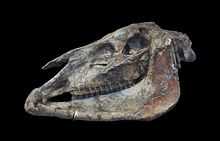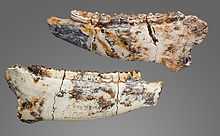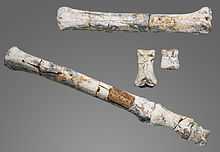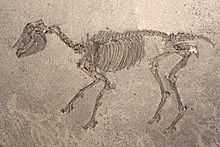Hippotherium
| Hippotherium Temporal range: 15–2Ma Mid Miocene to Pleistocene | |
|---|---|
| | |
| Skeleton of Hippotherium gracile, Staatliches Museum für Naturkunde Stuttgart | |
| Scientific classification | |
| Kingdom: | Animalia |
| Phylum: | Chordata |
| Class: | Mammalia |
| Order: | Perissodactyla |
| Family: | Equidae |
| Tribe: | Hipparionini |
| Genus: | Hippotherium Kaup (1832) |
| Species | |
| |
Hippotherium is an extinct genus of horse endemic to North America, to Asia, Europe, and Africa during the Miocene through Pliocene ~13.65—3.3 Mya, existing for 10.35 million years.
Taxonomy

Hippotherium was named by Kaup in 1832 and assigned to Equidae by Kaup 1833. It was named as a subgenus of Equus; type European E. gracilis. Its type is Equus primigenius. It was synonymized subjectively with Hipparion by MacFadden (1998) and Pesquero et al. (2006). It was assigned to the tribe Hipparionini by Alroy in 2002 and 2008.[1][2]
It was synonymized subjectively with Cormohipparion occidentale by MacFadden (1984) and was considered a nomen dubium by Macdonald (1992).[3][4]
Morphology
Body mass
A single specimen was examined by M. Mendoza, C. M. Janis, and P. Palmqvist for body mass.[5]
- Specimen: 61.5 kg (140 lb)
Fossil distribution
- Rattlesnake site, aka (SDSM V-832) Grant County, Oregon estimated age: ~7.8—7.7 Mya.
Species


H. emsliei
M. elatus is exclusive to the Southeastern U.S. It was named Cormohipparion emsliei by Hulbert, Jr. in 1988 and in 2006 by Hulbert and Whitmore in 2007. It became Hippotherium emsliei in 2001 by Alroy (J. Alroy).
Body mass
A single specimen was examined by M. Mendoza, C. M. Janis, and P. Palmqvist for body mass. (Mendoza et al.)
- Specimen: 48.7 kg (110 lb)
Fossil distribution
- Mauvilla site aka Ecor Rouge Sand, Mobile County, Alabama estimated age: ~10 Mya.
- Haile XVA aka Haile 15A, Alachua County, Florida, estimated age: ~3.7—3.6 Mya.
- Agrico Pierce Mine, Polk County, Florida, estimated age: ~10 Mya.
- Moss Acres Racetrack, Marion County, Florida estimated age: ~10.3—4.9 Mya.
H. ingenuum
H. ingenuum is exclusive to Central America and North America. It was named by Leidy (1885). Its type locality is Mixson's Bone Bed, which is in a Hemphillian terrestrial horizon in the Alachua Formation of Florida.
It was recombined as Hipparion ingenuum by Spencer (1895), Gidley (1907), Osborn (1918), Hay (1930) and Simpson (1930); it was synonymized subjectively with Hippotherium gratum by Lucas (1896). In 1909 it was recombined as Neohipparion ingenuum by Matthew, recombined as Nannippus ingenuus by Stirton (1940), Quinn (1955), Forsten (1975) and MacFadden (1984); it was recombined as Cormohipparion ingenuum by Hulbert (1988); it was considered a nomen dubium by Macdonald (1992).
Body mass A single specimen was examined by M. Mendoza, C. M. Janis, and P. Palmqvist for body mass. (Mendoza et al.).
- Specimen: 55.3 kg (120 lb)
Fossil distribution
- Las Culebras, Rancho Lobo, and Tepusuna, Honduras, Gracias Formation, estimated age: ~11.6—8.6 Mya.
- TMM 31204 aka John Dye Farm, Goliad County, Texas, estimated age: ~11.6—8.6 Mya.
- Occidental Mine, Statenville Formation, Hamilton County, Florida estimated age: ~11.7 Mya.
- Hog Creek Sarasota County, Florida estimated age: ~11.5—10.1 Mya.
H. plicatile
Hippotherium plicatile is exclusive to the state of Florida in North America. It was named by Leidy (1887). Its type locality is Mixson's Bone Bed, which is in a Hemphillian terrestrial horizon in the Alachua Formation of Florida.
It was recombined as Hipparion plicatile by Spencer (1895), Roger (1896), Trouessart (1898), Hay (1902), Gidley (1907), Sellards (1913), Osborn (1918), Matthew (1924), Simpson (1930), Stirton (1940) and Webb and Perrigo (1984); it was recombined as Neohipparion plicatile by Trouessart (1904), Matthew (1909) and Merriam (1913); it was recombined as Cormohipparion plicatile by Hulbert (1988); it was considered a nomen dubium by Macdonald (1992).[4][6][7]
Body mass
A single specimen was examined by M. Mendoza, C. M. Janis, and P. Palmqvist for body mass. (Mendoza et al.).
- Specimen: 80.1 kg (180 lb).
Fossil distribution
- Hog Creek Sarasota County, Florida estimated age: ~11.5—10.1 Mya.
- Haile 6A, Haile 5B, Gainesville Creek, Pareners Branch, and Coffrin Creek sites, Alachua County, Florida, estimated age: ~11.5—9.3 Mya.
- Withlacoochee River Site 4X, Citrus County, Florida estimated age: ~10.3—8.6 Mya.
H. primigenius

E. primigenius is exclusive to Europe and Africa. Its range extended from Northern Europe to South Africa. It was named by von Meyer. It is the type species of Hippotherium. It was recombined as Hipparion primigenium by Pesquero et al. (2006); it was recombined as Hippotherium primigenium by Kaup (1832) and Alroy (2008).
Fossil distribution
- Doue-la-Fontaine France estimated age: ~13.65—7.25 Mya.
- Lower Bakhtiari Formation, northern Iraq, estimated age: ~11.6—9.0 Mya.
- Kurtchuk-Tchekmedje, Turkey estimated age: ~11.61—5.33 Mya.
- Lang. E Quarry-GM aka ETE Locality 1042, Langebaanweg, "E Quarry, GM", South Africa.
H. quinni
Cormohipparion quinni is exclusive to the Great Plains of North America and was named by Woodburne in 1996. Its type locality is Devil's Gulch Horse Quarry, which is in a Barstovian terrestrial horizon in the Valentine Formation of Nebraska. It was recombined as Hippotherium quinni by Alroy (2007).
Body mass
A single specimen was examined by M. Mendoza, C. M. Janis, and P. Palmqvist for body mass. (Mendoza et al.).
- Specimen: 79.9 kg (180 lb).
- Kennesaw site, Logan County, Colorado estimated age: ~12.9 Mya.
- Devil's Jump Off, Nenzel Quarry, and Sawyer Quarry, and Valentine Railway Quarries, Cherry County, Nebraska 13-12.9 Mya.
- Schoettger Quarry, Keya Paha County, Nebraska 12.9-12.7 Mya.
References
- ↑ B. J. MacFadden. 1998. Equidae. In C. M. Janis, K. M. Scott, and L. L. Jacobs (eds.), Evolution of Tertiary Mammals of North America 1:537-559
- ↑ J. Alroy. 2008. Synonymies, reidentifications, and other arbitrary pronouncements mostly concerning fossil vertebrates.
- ↑ B. J. MacFadden. 1984. Systematics and phylogeny of Hipparion, Neohipparion, Nannippus, and Cormohipparion (Mammalia, Equidae) from the Miocene and Pliocene of the New World. Bulletin of the American Museum of Natural History 179(1):1-195
- ↑ 4.0 4.1 J. R. Macdonald. 1992. An analysis of the types of 147 named horse species and subspecies. Dakoterra 4:44-48
- ↑ M. Mendoza, C. M. Janis, and P. Palmqvist. 2006. Estimating the body mass of extinct ungulates: a study on the use of multiple regression. Journal of Zoology 270(1):90-101
- ↑ H. F. Osborn. 1918. Geological Society America Bulletin 29
- ↑ W. D. Matthew. 1909. The Carnivora and Insectivora of the Bridger Basin, middle Eocene. Memoirs of the American Museum of Natural History 9:289-567
| ||||||||||||||||||||||